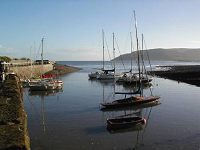PorlockGuide to Porlock village in West Somerset for visitors.
Porlock is a large village a few miles West of Minehead on the coast, surrounded by the wild moorland of
Exmoor to the South, Selworthy Hill to the East and Culbone Hill to the West.
The famous Porlock Hill, a 25% (1 in 4) incline with some very tight bends, on the main road leading West along the coast from the village was first ascended by motor car in 1900 for a bet. Horse drawn coaches operating the Minehead-Lynton route used this road until they were replaced by motor coaches in 1920. There is now a very scenic toll road avoiding the hill which is well signposted. Today, Porlock is a popular visitor destination throughout the year. Porlock is an ideal base from which to explore the wild and beautiful Exmoor National Park. There are lots of good hotels, inns, restaurants and shops. Porlock Weir (see pictures), a little port a mile West of the main village, played a vital part in the life of eastern Exmoor over the centuries when the sea route was by far the easiest way to and from the area. St. Dubricius' church in the village centre is interesting; it has a strange truncated spire on top of a low tower which are clad in oak shingles. The church has many outstanding monuments - the Harington being one of England's finest. |
Porlock Hotels Bed & Breakfast   Porlock Weir |
|
| The Porlock Tourist Association runs an excellent Visitor Centre in the old school building at the bottom of the hill on the junction where the Porlock Weir road joins the main road. Organised walks take place regularly from here. Guided by Park Rangers, the walk up over Ley Hill, south of the village searching for wild red deer is worth the effort on a summer evening. Another good woodland walk is the route from Porlock Weir up to Culbone Church - claimed to be the smallest church in England. |  |
|
History of PorlockTo the West of Porlock on the coast is Culbone Woods and well worth exploring. This was once the site of a major charcoal burning industry. The original burners were reputed to be a colony of lepers who were forbidden from crossing to the Porlock side of Culbone Water. Stone ruins marking the site of burners huts can still be seen and there is a network of tracks connecting them to the main route through the woods. A large group of feral goats lived in this coastal area until about 1910 and their milk, skins and meat were traded at Porlock Weir along with the charcoal. Oak-felling was another industry of the woods - some of the saw pits are still visible. Many tons were exported for ship building |
 |
Places to stay around Porlock
|
||||||||||||||||||






